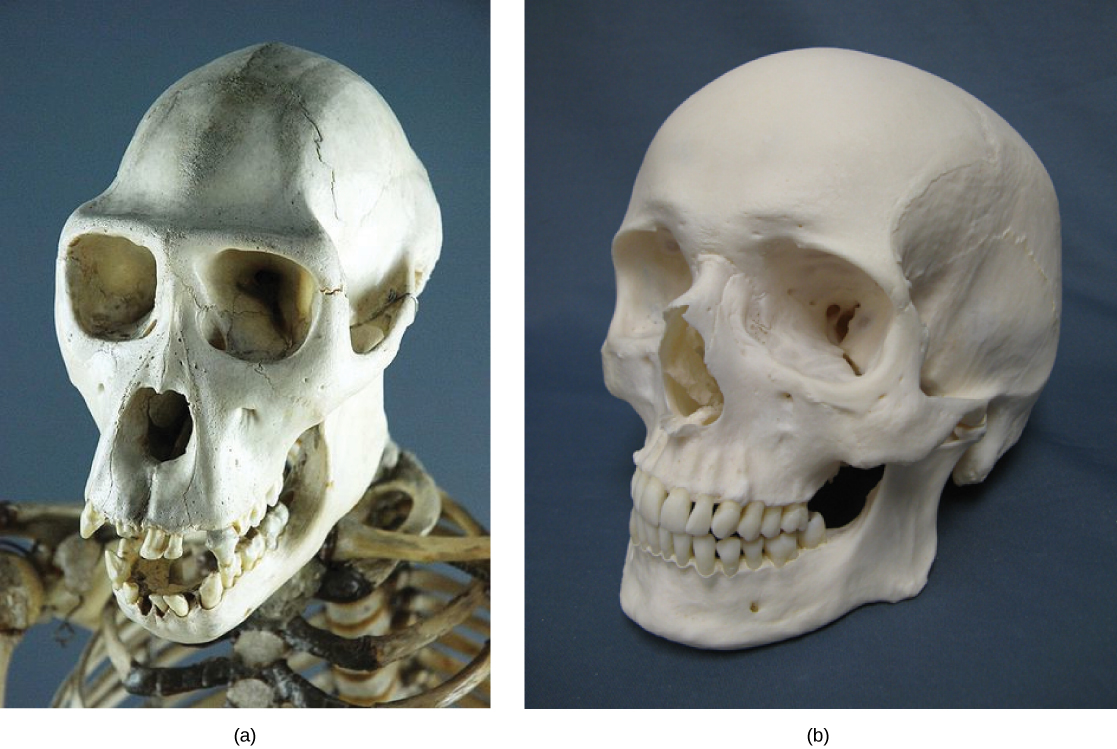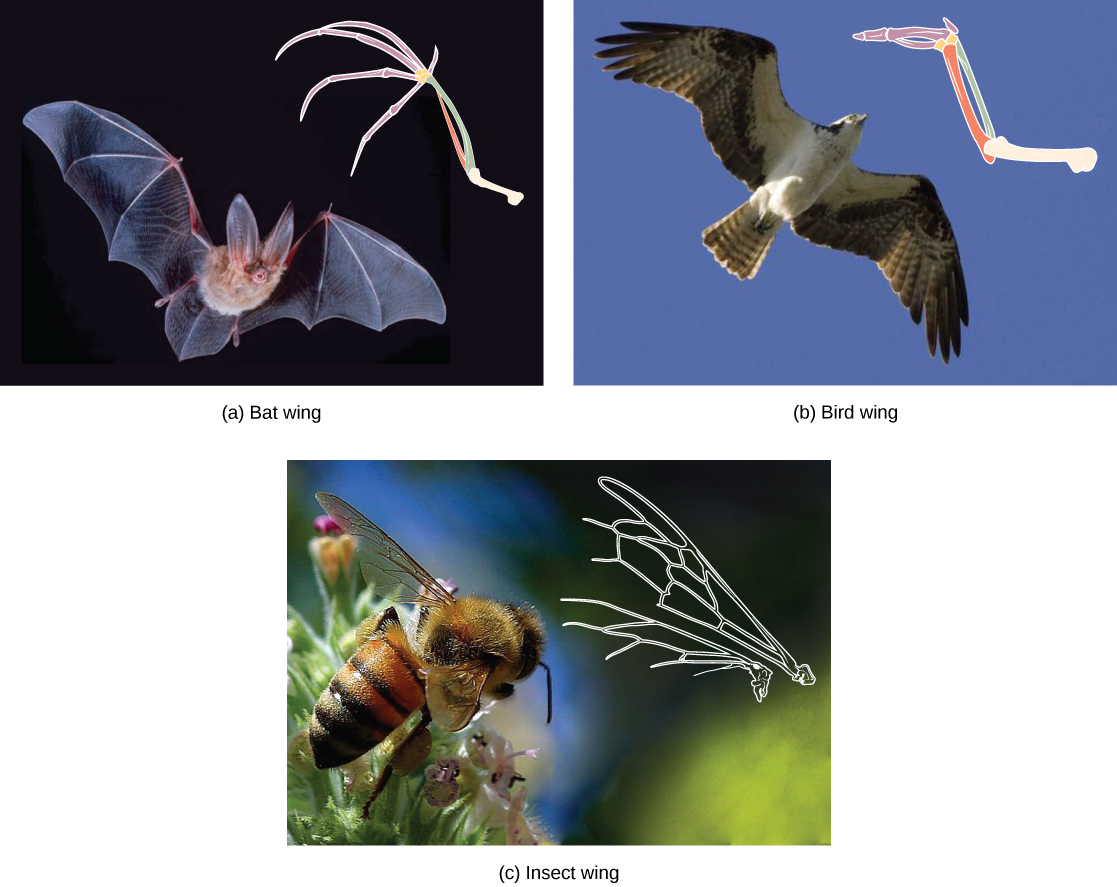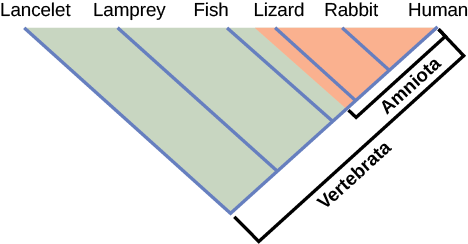What Information Would Be Helpful For Determining Whether An Organism Was A Plant Or An Animal?
12.2: Determining Evolutionary Relationships
- Page ID
- 7044
Scientists collect data that allows them to brand evolutionary connections between organisms. Like to detective work, scientists must employ evidence to uncover the facts. In the case of phylogeny, evolutionary investigations focus on two types of evidence: morphologic (form and function) and genetic.
2 Measures of Similarity
Organisms that share similar physical features and genetic sequences tend to exist more closely related than those that practise non. Features that overlap both morphologically and genetically are referred to every bit homologous structures; the similarities stem from common evolutionary paths. For instance, as shown in Figure \(\PageIndex{ane}\), the basic in the wings of bats and birds, the arms of humans, and the foreleg of a horse are homologous structures. Find the structure is not simply a single os, but rather a grouping of several bones bundled in a like way in each organism even though the elements of the structure may have changed shape and size.

Misleading Appearances
Some organisms may be very closely related, even though a minor genetic change caused a major morphological departure to make them look quite different. For case, chimpanzees and humans, the skulls of which are shown in Effigy \(\PageIndex{2}\) are very similar genetically, sharing 99 percentage 1 of their genes. However, chimpanzees and humans show considerable anatomical differences, including the degree to which the jaw protrudes in the adult and the relative lengths of our arms and legs.

However, unrelated organisms may exist distantly related however appear very much alike, normally considering common adaptations to similar ecology atmospheric condition evolved in both. An example is the streamlined trunk shapes, the shapes of fins and appendages, and the shape of the tails in fishes and whales, which are mammals. These structures conduct superficial similarity because they are adaptations to moving and maneuvering in the aforementioned environment—h2o. When a feature that is similar occurs by adaptive convergence (convergent evolution), and not because of a close evolutionary relationship, it is called an coordinating construction. In another example, insects use wings to fly like bats and birds. We call them both wings because they perform the same function and have a superficially like form, merely the embryonic origin of the ii wings is completely different. The difference in the development, or embryogenesis, of the wings in each example is a betoken that insects and bats or birds do not share a mutual ancestor that had a wing. The wing structures, shown in Figure \(\PageIndex{3}\) evolved independently in the two lineages.
Similar traits can be either homologous or analogous. Homologous traits share an evolutionary path that led to the development of that trait, and coordinating traits do not. Scientists must determine which type of similarity a feature exhibits to decipher the phylogeny of the organisms being studied.

Molecular Comparisons
With the advancement of Dna engineering science, the area of molecular systematics, which describes the apply of data on the molecular level including Deoxyribonucleic acid sequencing, has blossomed. New assay of molecular characters not merely confirms many before classifications, simply also uncovers previously made errors. Molecular characters can include differences in the amino-acid sequence of a poly peptide, differences in the individual nucleotide sequence of a cistron, or differences in the arrangements of genes. Phylogenies based on molecular characters assume that the more than like the sequences are in ii organisms, the more closely related they are. Different genes change evolutionarily at unlike rates and this affects the level at which they are useful at identifying relationships. Rapidly evolving sequences are useful for determining the relationships among closely related species. More than slowly evolving sequences are useful for determining the relationships between distantly related species. To determine the relationships between very unlike species such as Eukarya and Archaea, the genes used must be very aboriginal, slowly evolving genes that are present in both groups, such every bit the genes for ribosomal RNA. Comparing phylogenetic trees using different sequences and finding them like helps to build conviction in the inferred relationships.
Sometimes two segments of DNA in distantly related organisms randomly share a high percentage of bases in the aforementioned locations, causing these organisms to appear closely related when they are not. For example, the fruit fly shares 60 per centum of its Deoxyribonucleic acid with humans. 2 In this situation, computer-based statistical algorithms accept been adult to help place the actual relationships, and ultimately, the coupled apply of both morphologic and molecular information is more than effective in determining phylogeny.
EVOLUTION IN Activity: Why Does Phylogeny Affair?
In addition to enhancing our understanding of the evolutionary history of species, our ain included, phylogenetic assay has numerous practical applications. Two of those applications include understanding the evolution and transmission of disease and making decisions most conservation efforts. A 2010 study three of MRSA (methicillin-resistant Staphylococcus aureus), an antibody resistant pathogenic bacterium, traced the origin and spread of the strain throughout the by 40 years. The study uncovered the timing and patterns in which the resistant strain moved from its point of origin in Europe to centers of infection and development in South America, Asia, North America, and Australasia. The study suggested that introductions of the leaner to new populations occurred very few times, perhaps only once, and and so spread from that express number of individuals. This is in contrast to the possibility that many individuals had carried the bacteria from one place to another. This upshot suggests that public health officials should concentrate on quickly identifying the contacts of individuals infected with a new strain of bacteria to control its spread.
A 2nd surface area of usefulness for phylogenetic analysis is in conservation. Biologists have argued that it is important to protect species throughout a phylogenetic tree rather than but those from one branch of the tree. Doing this will preserve more of the variation produced past evolution. For example, conservation efforts should focus on a single species without sister species rather than another species that has a cluster of close sis species that recently evolved. If the unmarried evolutionarily singled-out species goes extinct a asymmetric amount of variation from the tree will be lost compared to i species in the cluster of closely related species. A study published in 2007 four made recommendations for conservation of mammal species worldwide based on how evolutionarily distinct and at risk of extinction they are. The study institute that their recommendations differed from priorities based on merely the level of extinction threat to the species. The report recommended protecting some threatened and valued large mammals such equally the orangutans, the giant and bottom pandas, and the African and Asian elephants. But they also found that some much lesser known species should be protected based on how evolutionary distinct they are. These include a number of rodents, bats, shrews and hedgehogs. In addition there are some critically endangered species that did non rate every bit very important in evolutionary distinctiveness including species of deer mice and gerbils. While many criteria affect conservation decisions, preserving phylogenetic diversity provides an objective way to protect the full range of diversity generated by evolution.
Edifice Phylogenetic Trees
How exercise scientists construct phylogenetic trees? Soon, the almost accepted method for constructing phylogenetic trees is a method called cladistics. This method sorts organisms into clades, groups of organisms that are most closely related to each other and the ancestor from which they descended. For example, in Figure \(\PageIndex{4}\), all of the organisms in the shaded region evolved from a single ancestor that had amniotic eggs. Consequently, all of these organisms too have amniotic eggs and make a single clade, also called a monophyletic group. Clades must include the bequeathed species and all of the descendants from a branch point.
Fine art Connectedness

Which animals in this figure belong to a clade that includes animals with hair? Which evolved first: hair or the amniotic egg?
Clades can vary in size depending on which branch bespeak is being referenced. The important gene is that all of the organisms in the clade or monophyletic group stalk from a unmarried indicate on the tree. This can be remembered because monophyletic breaks downwards into "mono," meaning ane, and "phyletic," meaning evolutionary relationship.
Shared Characteristics
Cladistics rests on three assumptions. The commencement is that living things are related by descent from a common ancestor, which is a general assumption of evolution. The 2nd is that speciation occurs by splits of 1 species into two, never more than two at a time, and essentially at one point in time. This is somewhat controversial, but is acceptable to virtually biologists as a simplification. The third supposition is that traits alter enough over time to be considered to be in a dissimilar state .Information technology is also assumed that one tin can identify the actual direction of change for a state. In other words, we assume that an amniotic egg is a later on character country than non-amniotic eggs. This is chosen the polarity of the character change. Nosotros know this by reference to a group outside the clade: for instance, insects have not-amniotic eggs; therefore, this is the older or ancestral character state. Cladistics compares ingroups and outgroups. An ingroup (lizard, rabbit and human in our example) is the group of taxa being analyzed. An outgroup (lancelet, lamprey and fish in our instance) is a species or group of species that diverged before the lineage containing the grouping(s) of interest. By comparison ingroup members to each other and to the outgroup members, nosotros can determine which characteristics are evolutionary modifications determining the branch points of the ingroup's phylogeny.
If a feature is found in all of the members of a group, information technology is a shared ancestral characterbecause there has been no alter in the trait during the descent of each of the members of the clade. Although these traits announced interesting considering they unify the clade, in cladistics they are considered non helpful when we are trying to make up one's mind the relationships of the members of the clade considering every member is the same. In contrast, consider the amniotic egg characteristic of Figure \(\PageIndex{four}\). Only some of the organisms have this trait, and to those that do, information technology is chosen a shared derived graphic symbol because this trait changed at some indicate during descent. This character does tell us virtually the relationships among the members of the clade; it tells united states of america that lizards, rabbits, and humans group more closely together than any of these organisms practise with fish, lampreys, and lancelets.
A sometimes disruptive attribute of "bequeathed" and "derived" characters is that these terms are relative. The aforementioned trait could exist either ancestral or derived depending on the diagram being used and the organisms beingness compared. Scientists observe these terms useful when distinguishing betwixt clades during the building of phylogenetic copse, just it is important to remember that their meaning depends on context.
Choosing the Correct Relationships
Constructing a phylogenetic tree, or cladogram, from the grapheme data is a monumental task that is usually left upward to a figurer. The figurer draws a tree such that all of the clades share the aforementioned list of derived characters. Merely there are other decisions to exist made, for case, what if a species presence in a clade is supported by all of the shared derived characters for that clade except one? One conclusion is that the trait evolved in the ancestor, but then inverse back in that one species. Likewise a character country that appears in two clades must be causeless to have evolved independently in those clades. These inconsistencies are common in trees fatigued from character data and complicate the controlling procedure nigh which tree virtually closely represents the real relationships among the taxa.
To aid in the tremendous task of choosing the all-time tree, scientists oftentimes employ a concept chosen maximum parsimony, which means that events occurred in the simplest, virtually obvious way. This means that the "best" tree is the 1 with the fewest number of grapheme reversals, the fewest number of independent graphic symbol changes, and the fewest number of grapheme changes throughout the tree. Estimator programs search through all of the possible trees to discover the small number of trees with the simplest evolutionary pathways. Starting with all of the homologous traits in a grouping of organisms, scientists can determine the order of evolutionary events of which those traits occurred that is the most obvious and uncomplicated.
CONCEPT IN Activeness

Practice Parsimony: Go to this website to learn how maximum parsimony is used to create phylogenetic trees (be sure to keep to the 2d page).
These tools and concepts are merely a few of the strategies scientists use to tackle the task of revealing the evolutionary history of life on Globe. Recently, newer technologies accept uncovered surprising discoveries with unexpected relationships, such as the fact that people seem to exist more closely related to fungi than fungi are to plants. Audio unbelievable? Every bit the information about DNA sequences grows, scientists will get closer to mapping the evolutionary history of all life on World.
Department Summary
To build phylogenetic copse, scientists must collect grapheme information that allows them to make evolutionary connections between organisms. Using morphologic and molecular data, scientists piece of work to place homologous characteristics and genes. Similarities between organisms tin stem either from shared evolutionary history (homologies) or from split evolutionary paths (analogies). After homologous data is identified, scientists use cladistics to organize these events every bit a means to decide an evolutionary timeline. Scientists employ the concept of maximum parsimony, which states that the likeliest social club of events is probably the simplest shortest path. For evolutionary events, this would be the path with the least number of major divergences that correlate with the bear witness.
Art Connections
Effigy \(\PageIndex{3}\): Which animals in this effigy belong to a clade that includes animals with pilus? Which evolved kickoff: pilus or the amniotic egg?
- Answer
-
Rabbits and humans belong in the clade that includes animals with hair. The amniotic egg evolved before hair, because the Amniota clade branches off earlier than the clade that encompasses animals with pilus.
Footnotes
- 1 Gibbons, A. (2012, June thirteen). Science Now. Retrieved from news.sciencemag.org/scienceno...sequenced.html
- 2 Background on comparative genomic analysis. (2002, December). Retrieved from http://www.genome.gov/10005835
- three Harris, S.R. et al. 2010. Evolution of MRSA during hospital manual and intercontinental spread. Science 327:469–474.
- 4 Isaac NJ, Turvey ST, Collen B, Waterman C, Baillie JE (2007) Mammals on the Border: Conservation Priorities Based on Threat and Phylogeny. PLoS ONE ii(3): e296. doi:x.1371/journal.pone.0000296
Glossary
- analogous structure
- a grapheme found in 2 taxa that looks similar because of convergent development, not because of descent from a common ancestor
- clade
- a group of taxa with the same set up of shared derived characters, including an ancestral species and all its descendants
- cladistics
- a method used to organize homologous traits to draw phylogenies using common descendent as the primary criterion used to classify organisms
- maximum parsimony
- applying the simplest, nearly obvious manner with the to the lowest degree number of steps
- molecular systematics
- the methods of using molecular show to identify phylogenetic relationships
- monophyletic group
- (too, clade) organisms that share a unmarried antecedent
- shared ancestral character
- a character on a phylogenetic branch that is shared by a detail clade
- shared derived character
- a grapheme on a phylogenetic tree that is shared only by a sure clade of organisms
Contributors and Attributions
-
Samantha Fowler (Clayton Country University), Rebecca Roush (Sandhills Community College), James Wise (Hampton University). Original content by OpenStax (CC BY 4.0; Admission for free at https://cnx.org/contents/b3c1e1d2-83...iv-e119a8aafbdd).
Source: https://bio.libretexts.org/Bookshelves/Introductory_and_General_Biology/Book%3A_Concepts_in_Biology_(OpenStax)/12%3A_Diversity_of_Life/12.02%3A_Determining_Evolutionary_Relationships
Posted by: goodmancrooking1973.blogspot.com

0 Response to "What Information Would Be Helpful For Determining Whether An Organism Was A Plant Or An Animal?"
Post a Comment